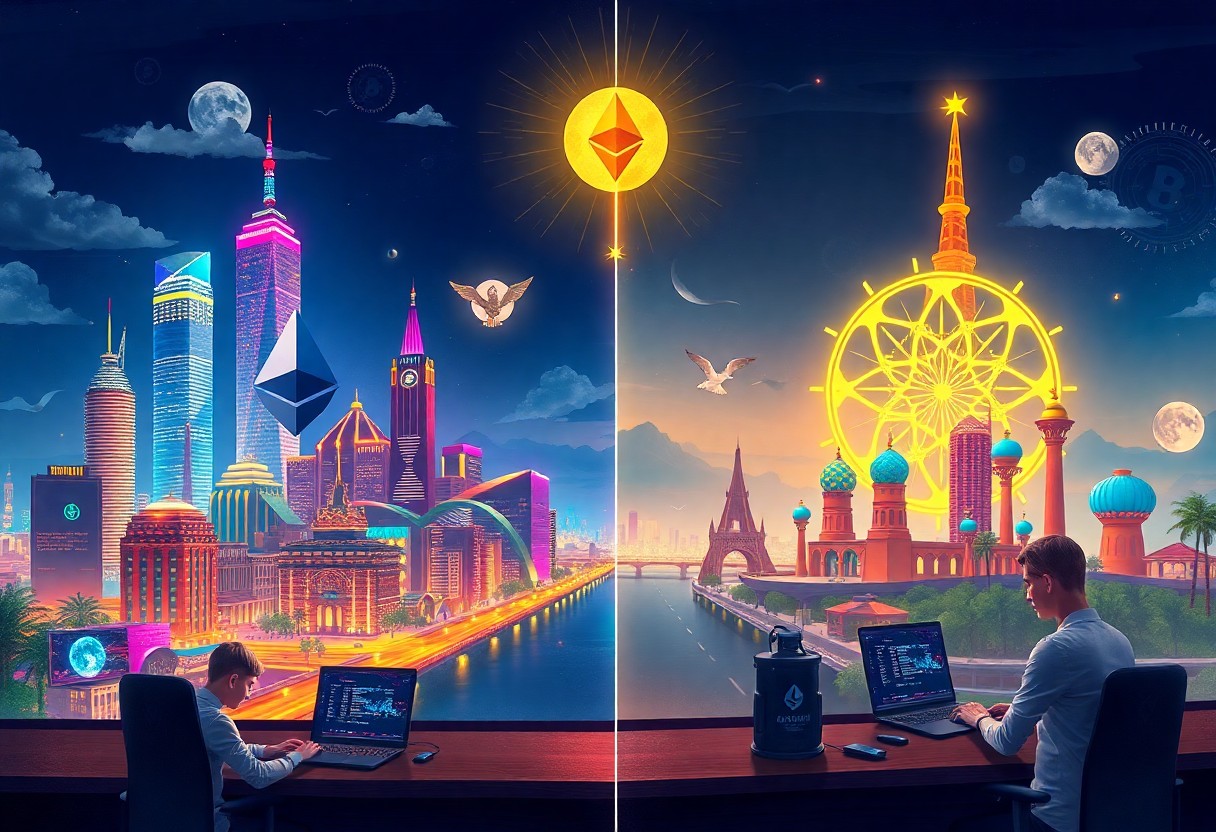Now Reading: Ethereum vs. Solana – Which blockchain is winning developer adoption?
-
01
Ethereum vs. Solana – Which blockchain is winning developer adoption?
Ethereum vs. Solana – Which blockchain is winning developer adoption?

With the rapid evolution of blockchain technology, you may find yourself questioning which platform—Ethereum or Solana—is capturing your attention as a developer. Both ecosystems offer distinct advantages and challenges, influencing how you can create and deploy decentralized applications. As you navigate through this competitive landscape, understanding the developer adoption trends, network capabilities, and community support for each blockchain will be key to making informed decisions about your projects.
Key Takeaways:
- Developer Activity: Ethereum continues to lead in developer activity with a larger number of active contributors and more established development tools.
- Transaction Speed: Solana boasts significantly higher transaction speeds and lower fees, attracting projects that prioritize scalability.
- Ecosystem Maturity: Ethereum has a more mature ecosystem, offering a wide array of applications and integrations which benefits new developers.
- Community Support: Ethereum has a robust community that provides strong support and resources for developers, enhancing adoption rates.
- Innovative Features: Solana’s unique features, like its proof-of-history consensus, are appealing to developers focusing on building high-performance applications.
Overview of Ethereum
The Ethereum network, launched in 2015, is a decentralized platform enabling developers to create and deploy smart contracts and decentralized applications (dApps). Its thriving ecosystem has gained significant traction among developers and users alike. For a deeper insight into the comparison between Ethereum and Solana, check out Solana vs Ethereum: Which is Better for Developers and ….
History and Evolution
The Ethereum blockchain was conceived by Vitalik Buterin, with the goal of enhancing blockchain technology beyond cryptocurrency transactions. It introduced smart contracts, enabling programmable transactions, and has undergone several upgrades, including Ethereum 2.0, which aims to improve scalability and reduce energy consumption. This constant evolution allows you to benefit from enhanced features and security.
Key Features and Upgrades
Beside its innovative smart contracts, Ethereum boasts several key features that contribute to its popularity:
- Smart Contracts: Automated transactions minimizing human intervention.
- Decentralized Applications (dApps): Enable the creation of various applications across multiple industries.
- Proof of Stake (PoS): Transitioning from Proof of Work (PoW) to enhance network efficiency and sustainability.
- Layer 2 Solutions: These solutions, such as Optimistic Rollups, improving scalability.
Recognizing these advancements, Ethereum continues to solidify its position in the blockchain space.
Even more impressive is Ethereum’s ongoing commitment to development and community support, which further enhances its core functionalities. The focus on scalability and energy efficiency through:
- Sharding: Improves transaction speeds and capacity.
- Interoperability: Allows better communication between networks.
- Community Governance: Engages users in protocol development.
- Increased Security Features: Protects smart contracts against vulnerabilities.
Recognizing these features positions Ethereum as a leading choice for developers looking to innovate within the blockchain ecosystem.
Overview of Solana
Some consider Solana a cutting-edge blockchain platform designed to support high-performance decentralized applications and crypto projects. With its ability to scale and process transactions at lightning speed, Solana has become a popular choice among developers looking for efficient solutions for their applications. As you explore this platform, you will discover its unique approach to achieving enhanced throughput and lower fees, which sets it apart from its competitors.
History and Evolution
One of the standout features of Solana is its relatively short yet dynamic history. Founded in 2017 by Anatoly Yakovenko, Solana was created in response to challenges faced by existing blockchain ecosystems. In 2020, it launched its mainnet, and its speed and efficiency attracted significant developer interest. Since then, Solana has continued to evolve, building a robust ecosystem of decentralized applications and projects that showcase its capabilities.
Key Features and Innovations
Innovations in Solana include various cutting-edge features that optimize its performance and usability. These include:
- High Throughput: Capable of processing up to 65,000 transactions per second.
- Low Fees: Minimal transaction costs, often less than a cent.
- Unique Consensus Mechanism: Utilizes Proof of History for synchronization.
- Scalability: Seamlessly adapts to increasing network demand.
- Developer-Friendly Tools: Offers a suite of tools to aid in easy app deployment.
Any developer looking to build on a fast and affordable blockchain will find Solana a compelling choice.
History reveals that Solana was engineered with speed and efficiency in mind, addressing the pain points often experienced on other blockchains. Its architecture prioritizes rapid transaction processing, allowing developers to create adaptable and scalable applications. Furthermore, Solana’s emphasis on low costs and ease of use positions it well in the competitive landscape. You should bear in mind that its growing community and consistent upgrades make it an attractive blockchain environment for innovative projects and decentralized applications. Any knowledge you gain about Solana will aid you in understanding its profound impact on the blockchain sector.
Developer Adoption Metrics
After examining the developer adoption metrics, you’ll find that both Ethereum and Solana have unique strengths that appeal to different types of developers. Understanding these metrics, including active developer counts and project contributions, can help you gauge which blockchain may better align with your goals and preferences. Your choice could significantly impact your project’s success and sustainability.
Popularity and Usage Statistics
Any examination of popularity and usage statistics reveals that Ethereum continues to dominate the space in terms of total transactions and smart contract implementations. However, Solana offers impressive growth metrics, capturing attention with its rapid transaction speeds and lower fees. As a developer, analyzing these statistics can guide your decision on where to build your projects.
Development Ecosystem and Tools
About the development ecosystem and tools, both Ethereum and Solana provide ample resources for builders. Ethereum’s mature ecosystem includes various libraries, frameworks, and extensive documentation, which can enhance your development experience. In contrast, Solana offers unique tools like Anchor for streamlined contract development, but it may not have the same breadth as Ethereum’s offerings.
This complementary structure of ecosystems means that you can find different tools tailored to your development needs. Ethereum’s established framework shines in offering comprehensive educational resources and a larger developer community, which can be a significant advantage when facing challenges. On the other hand, Solana’s unique tools enable you to build with innovative approaches while benefiting from faster transaction capabilities. Your expertise and project requirements will ultimately dictate which ecosystem serves you better.
Comparative Analysis
For a deeper understanding of the strengths and weaknesses of Ethereum and Solana in developer adoption, the following table summarizes key aspects:
| Criteria | Ethereum | Solana |
|---|---|---|
| Scalability | Moderate, with ongoing upgrades (e.g., Ethereum 2.0) | High, with rapid transaction speeds |
| Performance | Slower transactions, higher fees | Fast transactions, lower fees |
| Developer Support | Strong community resources, extensive documentation | Growing community, but fewer resources |
Scalability and Performance
Against Ethereum’s historical challenges, Solana’s architecture enables it to achieve significantly higher throughput, often processing thousands of transactions per second. This high performance allows developers to build applications that require rapid response times without the bottlenecks often experienced on Ethereum. However, as Ethereum transitions to layer two solutions and other upgrades, its potential for scalability is also improving.
Community and Developer Support
Before venturing into the technical specifics, it’s important to recognize the impact of community on developer support. Developers often prefer environments with robust community backing, as it facilitates networking, shared knowledge, and troubleshooting. Ethereum’s longstanding position has resulted in a vast network of resources and experienced developers, while Solana’s ecosystem is expanding quickly but still has limited resources compared to Ethereum.
For instance, while Ethereum offers an extensive array of developer tools and community forums where developers can seek assistance, Solana has been racing to build out its own infrastructure. The rapid growth of Solana has led to a vibrant developer community, but you may find fewer tutorials and less extensive documentation. This might mean less help when you’re starting out, which can impact your development process. Understanding these differences will help you make informed decisions based on your project’s needs.
Economic Considerations
All developers must take into account various economic factors when choosing between Ethereum and Solana. From transaction costs to incentives, these elements can significantly impact your project’s bottom line and overall success. Understanding these considerations can help you make an informed decision suitable for your development needs.
Transaction Costs and Fees
Considerations about transaction costs are vital in your blockchain choice, as both Ethereum and Solana present differing fee structures. Ethereum has faced issues with high gas fees during peak usage, which can hinder your project’s profitability. In contrast, Solana offers significantly lower fees, making it an attractive option for developers seeking to maximize their budget.
Incentives for Developers
For you, comprehending the incentives available for developers on each blockchain can influence your choice significantly. Solana usually provides grants, resources, and community support that can be beneficial for your project. Meanwhile, Ethereum boasts a more established ecosystem with a wealth of tools and resources, albeit with higher costs.
To explore the incentives further, you should note that Solana’s aggressive grant initiatives and low fees provide a supportive environment for newcomers. In comparison, while Ethereum offers robust community resources, the higher operational costs can sometimes be a barrier for development. Understanding both ecosystems’ strengths allows you to position your project effectively, taking advantage of support systems ensuring your efforts yield the best results in the ever-evolving blockchain landscape.
Case Studies
Not only do Ethereum and Solana boast impressive developer ecosystems, but several case studies also provide insights into their adoption trends. Consider the following:
- Ethereum: Over 3,000 decentralized applications (dApps) launched, handling more than 1 million daily transactions.
- Solana: More than 1,500 active dApps with a transaction throughput exceeding 65,000 transactions per second.
- Ethereum: Average developer salary around $133,000, highlighting high demand.
- Solana: Over $5 billion in total value locked (TVL) in decentralized finance (DeFi) applications.
Successful Projects on Ethereum
Along the way, Ethereum has birthed notable projects like Uniswap, a leading decentralized exchange, which has facilitated over $1 trillion in trading volume. Other successful projects include Aave, a decentralized lending platform with over $12 billion TVL, and OpenSea, the largest NFT marketplace, which has registered more than $30 billion in total sales. These statistics underline Ethereum’s pervasive influence within the blockchain landscape.
Successful Projects on Solana
One exemplary blockchain is Solana, home to rapid-growing projects such as Serum, a decentralized exchange that provides an order book model and supports 65,000 transactions per second. Another is Raydium, a liquidity provider for the ecosystem, boasting over $1.8 billion in TVL, and Star Atlas, a metaverse gaming project that raised $16 million in its initial sale. These figures highlight the momentum and attraction Solana has generated in the blockchain community.
Understanding the growth of successful projects on Solana reveals a landscape where speed and affordability attract developers. With its ability to handle thousands of transactions at low fees, Solana continues to draw interest from developers focused on scalability. However, the ecosystem is still evolving, and along with the potential for exponential growth, there are also concerns regarding network stability and how it will handle increased demand. These nuances are critical for you to consider when assessing the long-term viability of projects built on Solana.
Conclusion
Presently, as you evaluate Ethereum and Solana in terms of developer adoption, it’s clear that both platforms have unique strengths. Ethereum continues to lead with its established community and extensive ecosystem, while Solana showcases rapid growth and innovative features. Your decision on which blockchain to engage with may depend on your specific project needs, desired speed, and scalability. Staying informed about their ongoing developments will empower you to make the best choice for your future endeavors in the blockchain space.
FAQ
Q: What are the key differences between Ethereum and Solana in terms of technology?
A: Ethereum operates on a proof-of-stake consensus mechanism and has a more established ecosystem with extensive tooling for developers. It offers robust smart contract functionality through its Ethereum Virtual Machine (EVM). Solana, on the other hand, utilizes a unique proof-of-history technology that allows for significantly faster transaction speeds and lower costs. This difference in architecture makes Solana appealing for developers looking to build high-performance applications with quick confirmation times.
Q: How does developer support and community engagement compare between Ethereum and Solana?
A: Ethereum boasts a large, established community with extensive resources, libraries, and developer tools that make it easier for new and existing developers to create and maintain decentralized applications (dApps). There are numerous online forums, tutorials, and events that provide support. Solana, while having a smaller community, has grown rapidly and provides strong support through grants, hackathons, and a growing network of resource centers which helps in attracting new developers.
Q: What are the key factors driving developer adoption between Ethereum and Solana?
A: Developer adoption can be influenced by various factors such as transaction speed, cost of development, scalability, and language compatibility. Ethereum is widely recognized for its security and has built a reputation over many years, which attracts developers wanting to build reliable applications. Conversely, Solana’s higher throughput and lower transaction fees are enticing for projects focused on high-frequency trading, gaming, and Web3 applications, pushing many developers to explore opportunities on its platform.
Q: How do decentralization and security impact the choice between Ethereum and Solana for developers?
A: Ethereum’s long-standing focus on decentralization and security has made it a trusted platform, with a robust network of validators that ensures solid transaction verification. This aspect is critical for developers prioritizing these principles. Solana’s centralized aspects, such as a smaller number of active validators, have raised concerns among some developers regarding its resilience against attacks and censorship, potentially influencing their decision on which blockchain to adopt for their projects.
Q: What are the future prospects for Ethereum and Solana in terms of developer adoption?
A: Ethereum is continuously evolving, especially post-merge to proof-of-stake, focusing on scalability and efficiency enhancements like sharding in future upgrades, which could maintain or even increase its developer base. Simultaneously, Solana is rapidly gaining traction with its innovative architecture and offers promising growth potential due to its community initiatives and partnerships. Both platforms could coexist, with specific use cases favoring one blockchain over the other based on developer needs and preferences.























